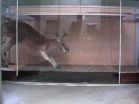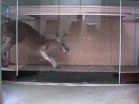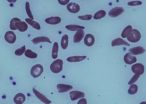(Press-News.org) VIDEO:
This video is an analysis of video of kangaroos walking has helped scientists discover how important their tails are during locomotion.
Click here for more information.
Kangaroos may be nature's best hoppers. But when they are grazing on all fours, which is most of the time, their tail becomes a powerful fifth leg, says a new study.
Involving researchers at the University of Colorado Boulder, Simon Fraser University in Burnaby, Canada, and the University of New South Wales in Sydney, Australia, the study illuminates the seemingly mundane task of foraging by red kangaroos. While such activity appears awkward, it turns out their tails provide as much propulsive force as their front and hind legs combined as they eat their way across the landscape.
"We found that when a kangaroo is walking, it uses its tail just like a leg," said Associate Professor Maxwell Donelan of Simon Fraser University, corresponding author for the study. "They use it to support, propel and power their motion. In fact, they perform as much mechanical work with their tails as we do with one of our legs."
"We went into this thinking the tail was primarily used like a strut, a balancing pole, or a one-legged milking stool," said Associate Professor Rodger Kram of CU-Boulder's Department of Integrative Physiology, a study co-author. "What we didn't expect to find was how much power the tails of the kangaroos were producing. It was pretty darn surprising."
Red kangaroos are the largest of the kangaroo species in Australia. When grazing on grasses, they move both hind feet forward "paired limb" style while using their tails and front limbs together to support their bodies. "They appear to be awkward and ungainly walkers when one watches them moseying around in their mobs looking for something to eat," said Kram. "But it turns out it is not really that awkward, just weird."
In human locomotion, the back foot acts as the gas pedal and the front foot acts as a brake, which is not especially efficient, said Kram. But he likens a walking kangaroo to a skateboarder who has one foot on the board and uses the other foot -- in this case a tail -- to push backward off the pavement, increasing the forward motion.
A paper on the subject was published online today in Biology Letters. In addition to Kram and Donelan, the paper was co-authored by Postdoctoral Fellow Shawn O'Connor of Simon Fraser and Emeritus Professor Terence Dawson of the University of New South Wales. The study was funded by the Natural Sciences and Engineering Research Council of Canada, the Australian Research Council, and traveling fellowships from the International Society for Biomechanics and the Journal of Experimental Biology.
Donelan, a former graduate student under Kram, said no animal other than the kangaroo uses its tail like a leg. "Their tails have more than 20 vertebrae, taking on the role of our foot, calf, and thigh bones."
The research project had its beginnings in 1973, when Dawson, a visiting professor at Harvard University, was working with Harvard Professor Richard Taylor, who later became Kram's advisor. Dawson coaxed a small group of kangaroos to hop and walk on a large motorized treadmill, with a goal of measuring the energy costs of locomotion at varying speeds. Dawson and Kram eventually showed that a kangaroo can increase its metabolism by 50 times during exercise.
"Kangaroos are really special mammals," said Dawson. "Work over the past half century has turned the notion that they belong to an inefficient, primitive group of mammals totally on its head."
The kangaroo tail also acts as a dynamic, springy counterbalance during hopping and boosts balance when male kangaroos grab each other by the chests or shoulders, then rear back and kick each other in the stomach in an attempt to assert dominance for the purpose of reproduction.
For the study the team videotaped five red kangaroos in Dawson's Sydney lab that had been trained to walk forward on a force-measuring platform with Plexiglas sides. The platform's sensors measured vertical, backward and forward forces from the legs and tails of the animals. The kangaroos had been taught that walking forward on the platform resulted in being rewarded with sweet treats, said Kram.
Over his career Kram and his students have studied the locomotion of a number of creatures, from elephants, tortoises and llamas to ostriches and beetles.
Although much of the data for the new study was collected years ago, other research efforts by the team members slowly pushed some of the key kangaroo locomotion data to the back burner. "But this was a study we just could not let go of," said Kram. "It was just too much fun. It's a real wonder of nature, how these kangaroos move about and what they are able to do."
Kram calls the evolution of the kangaroo tail, which is thought to have been prehensile when opossum-like kangaroo ancestors were living in trees, an "exaptation" -- a shift in the function of a biological trait over time. He likened it to a roll of duct tape in the back of a truck. "You know you are going to use it, you just don't know when," he said.
"I'm envious of kangaroos," said Kram, a competitive master runner in the mile and 1,500 meters. "When they hop faster, they don't use energy at a faster rate. The have the ability to move faster and not get tired, the ultimate goal of a runner."
INFORMATION:
New study involving CU-Boulder tells the tale of a kangaroo's tail
Researchers find when a kangaroo is walking, it uses its tail just like a leg
2014-07-02
ELSE PRESS RELEASES FROM THIS DATE:
The Lancet: Nearly 80 percent of US deaths in the first three decades of life are due to unintentional injury or violence
2014-07-02
A new report on unintentional injury and violence in the United States, published in The Lancet as part of a new Series, The health of Americans [1], has found that prevention strategies across society show a great deal of promise in preventing unintended deaths and injuries.
According to the report, by CDC researchers from Atlanta, USA, more Americans between the ages of one and 30 die from injury than from any other cause. Every year, nearly 180 000 people in the USA die from preventable causes such as automobile crashes, drowning, firearm-related injuries, falls, ...
The Lancet: Infectious diseases cause significant burden in the USA
2014-07-02
Infectious diseases remain major public health challenges in the United States, according to a new report published in The Lancet as part of a new Series, The health of Americans [1]. Endemic conditions such as chronic viral hepatitis, human immunodeficiency virus, and other sexually transmitted infections continue to affect millions of individuals, with racial and ethnic minorities disproportionately affected. Emerging and re-emerging vector borne and zoonotic disease infections are threatening new areas and populations, as most recently observed with Chikungunya. Despite ...
The Lancet: Chronic disease prevention one of 21st century's key challenges
2014-07-02
According to a report on chronic diseases by Centers for Disease Control and Prevention researchers, published in The Lancet as part of a new Series, The health of Americans [1], half of all adults in the USA suffer from at least one chronic condition, such as diabetes, heart disease, or obesity, and over a quarter of adults have two or more. The majority of these chronic conditions stem from a small number of risk factors that are largely preventable, including tobacco use, poor diet, and physical inactivity (both strongly associated with obesity), alcohol consumption, ...
Predicting the outcome of hepatitis C virus treatment
2014-07-02
Millions of people throughout the world are infected with hepatitis C virus (HCV), which can lead to cirrhosis of the liver and cancer. Directly acting antiviral agents inhibit viral proteins and have been used to successfully treat HCV. Unfortunately, antiviral therapy fails in some patients, resulting in a relapse of HCV. A study published in the Journal of Clinical Investigation identifies a marker that can identify patients likely to have an HCV relapse after antiviral therapy. Shyamasundaran Kottilil and colleagues at the NIH evaluated the immune response of HCV-infected ...
Bone marrow transplantation shows potential for treating adults with sickle cell disease
2014-07-01
Use of a lower intensity bone marrow transplantation method showed promising results among 30 patients (16-65 years of age) with severe sickle cell disease, according to a study in the July 2 issue of JAMA.
Myeloablative (use of high-dose chemotherapy or radiation) allogeneic hematopoietic stem cell transplantation (HSCT; receipt of hematopoietic stem cells "bone marrow" from another individual) is curative for children with severe sickle cell disease, but associated toxicity has made the procedure prohibitive for adults. The development of nonmyeloablative conditioning ...
Drug everolimus does not improve overall survival in patients with advanced liver cancer
2014-07-01
Despite strong preclinical data, the drug everolimus failed to improve overall survival in patients with advanced liver cancer, compared to placebo, according to a study in the July 2 issue of JAMA.
Patients with advanced hepatocellular carcinoma (HCC; a type of liver cancer) have a median overall survival of less than l year, largely because of the absence of effective therapies. The drug sorafenib is the only systemic therapy shown to significantly improve overall survival in advanced HCC; however its benefits are mostly transient and modest, and disease eventually ...
Study examines neurological outcomes for TBI treatments
2014-07-01
In patients with a traumatic brain injury (TBI), neither the administration of the hormone erythropoietin (EPO) or maintaining a higher hemoglobin concentration through blood transfusion resulted in improved neurological outcome at 6 months, according to a study in the July 2 issue of JAMA. Transfusing at higher hemoglobin concentrations was associated with a higher risk of adverse events.
Patients with severe traumatic brain injury commonly develop anemia. For patients with neurological injury, anemia is a potential cause of secondary injury, which may worsen neurological ...
Whole-exome sequencing helpful to id gene mutations linked to nervous system diseases
2014-07-01
Use of exome sequencing improved the ability to identify the underlying gene mutations in patients with biochemically defined defects affecting multiple mitochondrial respiratory chain complexes (enzymes that are involved in basic energy production), according to a study in the July 2 issue of JAMA.
Defects of the mitochondrial respiratory chain have emerged as the most common cause of childhood and adult neurometabolic disease, with an estimated prevalence of l in 5,000 live births. Clinically these disorders can present at any time of life, are often seen in association ...
Medicare-backed breast cancer screenings skyrocket, but do patients benefit?
2014-07-01
Breast cancer screening costs for Medicare patients skyrocketed between 2001 and 2009, but the increase did not lead to earlier detection of new breast cancer cases, according to a study published by Yale School of Medicine researchers in the July 1 Journal of the National Cancer Institute.
While the number of screening mammograms performed among Medicare patients remained stable during the same time period, the study focused on the adoption of newer imaging technologies in the Medicare population, such as digital mammography. Brigid Killelea, M.D., assistant professor ...
Adults stop anti-rejection drugs after stem-cell transplant reverses sickle cell disease
2014-07-01
Adults stop anti-rejection drugs after stem-cell transplant reverses sickle cell disease
NIH trial success suggests a new treatment option for older, sicker patients
Half of patients in a trial have safely stopped immunosuppressant medication following a modified blood stem-cell transplant for severe sickle cell disease, according to a study in the July 1 issue of the Journal of the American Medical Association. The trial was conducted at the National Institutes of Health's Clinical Center in Bethesda, Maryland, by researchers from NIH's National Institute of Diabetes ...
LAST 30 PRESS RELEASES:
Home-delivered groceries improve blood sugar control for people with diabetes facing food insecurity
MIT researchers identified three cognitive skills we use to infer what someone really means
The Iberian Peninsula is rotating clockwise according to new geodynamic data
SwRI, Trinity University to study stable bacterial proteins in search of medical advances
NIH-led study reveals role of mobile DNA elements in lung cancer progression
Stanford Medicine-led study identifies immune switch critical to autoimmunity, cancer
Research Alert: How the Immune System Stalls Weight Loss
Glucagon-like peptide 1 receptor agonist use and vertebral fracture risk in type 2 diabetes
Nonadherence to cervical cancer screening guidelines in commercially insured US adults
Contraception and castration linked to longer lifespan
An old jeweler’s trick could unlock next-generation nuclear clocks
Older age, chronic kidney disease and cerebrovascular disease linked with increased risk for paralysis and death after West Nile virus infection
New immune role discovered for specialized gut cells linked to celiac disease
A new ‘hypertropical’ climate is emerging in the Amazon
Integrated piezoelectric vibration and in situ force sensing for low-trauma tissue penetration
Three-hit model describes the causes of autism
Beech trees use seasonal soil moisture to optimize water uptake
How thinning benefits growth for all trees
Researchers upgrades 3-PG forest model for improved accuracy
Achieving anti-thermal-quenching in Tb3+-doped glass scintillators via dual-channel thermally enhanced energy transfer
Liquid metal modified hexagonal boron nitride flakes for efficient electromagnetic wave absorption and thermal management
Failure mechanisms in PEM water electrolyzers
Study captures how cancer cells hide from brain immune cells, shows that removing their “don’t eat me” signals stops their escape
New breakthrough in detecting ‘ghost particles’ from the Sun
Half of people arrested in London may have undiagnosed ADHD, study finds
From dots to lines: new database catalogs human gene types using ’ACTG’ rules
Persistent antibiotic resistance of cholera-causing bacteria in Africa revealed from a multinational workshop for strengthening disease surveillance
SwRI, Trinity University to synthesize novel compound to mitigate effects of stroke, heart attack
Novel endocrine therapy giredestrant improves disease-free survival over standard of care for patients with early-stage breast cancer in phase III lidERA trial
Gen Z views world as "scary place" with growing cynicism about ability to create change
[Press-News.org] New study involving CU-Boulder tells the tale of a kangaroo's tailResearchers find when a kangaroo is walking, it uses its tail just like a leg


